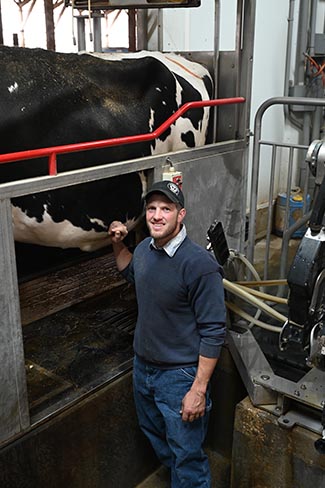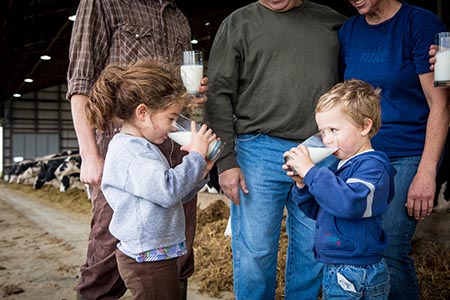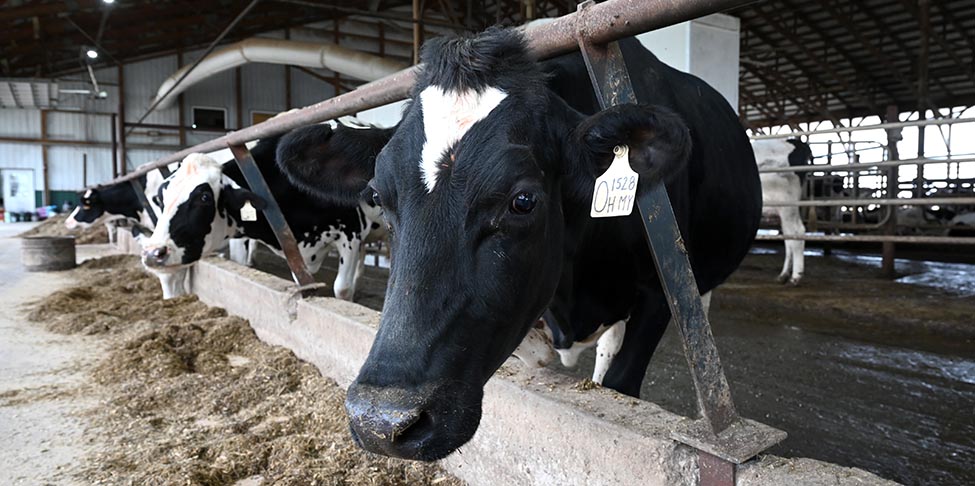From Moo to Me
February 6, 2024
By Haley Banwart
In every glass of milk, there's a complex journey from cow to cup involving meticulous steps and an uncompromising commitment to safety. While quality control measures are followed along the entire supply chain, the dairy farm is at the heart of milk safety.
New Day Dairy is a fifth-generation dairy farm owned and operated by Dan and Lynn Bolin. Located near Clarksville, the farm is one of more than 700 licensed milk-producing operations in Iowa. Like many other aspects of dairy farming, animal health and milk safety are top of mind 24/7, 365 days a year.

Clean and Healthy Cows
For dairy farmers like the Bolins, one of the first steps in providing quality milk products is maintaining clean and hygienic conditions for their dairy cows. Regular health checks and inspections contribute to the overall well-being of the animals and the safety of the milk they produce.
“Before any of our 120 cows are milked, safety starts with ensuring they are clean and healthy inside and out,” says Lynn. “On the inside, that means preventing illness to reduce the risk of pathogens passing through their milk.”
Cows receive vaccinations – just like people do – and medicine when they get sick. Vaccinations are an essential tool for preventing and controlling disease in the dairy herd, along with routine visits from a veterinarian.
At New Day Dairy, a vet visits the farm every two weeks to examine the cows. Each cow is given a thorough check-up twice a year and special treatment during and after pregnancy.
External environmental factors also play a critical role in keeping dairy cows clean and healthy, especially around their udders, where the milk is sourced. Sand bedding is used at the Bolin farm to ensure cleanliness and cow comfort.
“We like to joke our cows spend every day at the beach,” shares Lynn. “Sand is an ideal bedding because its natural inorganic material helps reduce bacterial growth and keeps the cows cool and dry where they sleep.”
“Manure, of course, can be another source of bacteria. Every two hours, our automatic scrapers pull away any manure to maintain a clean environment for our cows,” she adds.
An inspection from the Iowa Department of Agriculture and Land Stewardship (IDALS) is also completed every five months. IDALS provides permits to all Iowa dairy farms producing milk that is pasteurized.
Proper Milking Parlor Procedures 
The journey from farm to glass continues when cows arrive at the milking parlor. At New Day Dairy, it’s Rita, the automatic robotic milking machine.
Before milking begins, each of the cow’s four teats is sanitized to remove any residue or germs. Then, the milking cup is attached, and the creamy white fluid is vacuum-pumped through a series of tubes and piped into a temperature-controlled bulk tank.
“Just like any nursing mother, the milk exits the cow at the animal’s body temperature,” Lynn explains. “A plate cooler exchanges heat and uses well water to chill the milk as it enters the bulk tank, and the same water is recycled for the cows to drink.”
This starts the cold chain process where fluid milk is stored, processed and transported under controlled conditions to reduce the chance of contamination.
Once milking is complete, the cow’s teats are cleaned again to protect her udder from infection.
Post Milking Safeguards
What happens when a dairy cow gets sick? With routine testing and several safeguards in place, farmers closely monitor and manage individual cow and herd health.
“In some cases, an animal may show obvious signs of feeling unwell. Other times, the issue may be subclinical and require lab work to uncover what the naked eye can’t see,” says Lynn. “In either situation, the cow may need to be treated with an antibiotic, just like when we get sick.”
Using sensor technology, the Bolin’s robotic milker can detect spikes in bacterial activity and will automatically dump any milk indicating an infection is potentially present. The Bolins program the robot to divert milk from a sick cow to a separate tank before any medication is administered.
A third line of defense involves the milkman who collects milk from New Day Dairy every other day. Test tube samples are taken, labeled and put on ice during each visit. After the milk leaves the farm, the sample undergoes rigorous testing at the processing plant to confirm no antibiotics or bacteria are present before the shipment is unloaded.
In accordance with government regulations, any milk testing positive for antibiotics cannot be sold to the public.
Inside a Milk Processing Plant
Although shipments from New Day Dairy are sent to the Prairie Farms cheese plant in Luana, other locally sourced dairy products can be traced to the cooperative’s fluid milk plant in Dubuque. Inside the plant, the following steps are completed to ensure only safe and pure milk moves forward in the production process:
- Milk is cooled to 34 degrees F and pumped into silos. Any milk warmer than 45 degrees F is not accepted.
- From the silos, milk flows into the surge tank, where it is processed through three independent systems.
o Pasteurizer – Milk is quickly heated to 172 degrees F to kill off harmful bacteria, then cooled.
o Separator – Foreign matter and cream are separated out.
o Homogenizer – Fat globules are broken down and suspended in milk.
- Then, the milk is transferred to filling tanks where flavorings, like chocolate, can be mixed in.
- Finally, the milk is bottled, stored in a cooler and sent to store shelves the next day.
The Power of Pasteurization
Pasteurization, or the process of using heat to kill harmful bacteria, is a crucial step in guaranteeing the safety of milk consumed. This process preserves the nutritional value of the milk while making it safe for all family members to enjoy, from young children to older adults.
- High-Temperature Short Time (HTST) – This is the most common method of pasteurization used in the U.S. today. Milk is heated to at least 161 degrees F for no less than 15 seconds.
- Ultra Pasteurization (UP) – UP results in a product with a longer shelf life but still requires refrigeration. Milk must be heated to no less than 280 degrees F for two seconds.
- Ultra-High Temperature (UHT) – Aseptic processing of UHT milk produces a shelf-stable product that is useful as an emergency supply or when refrigeration is not available.
o One example of how this type of milk is used would be in a child’s day camp sack lunch.
History of Milk Hygiene 
Today, milk is one of the safest foods we can consume. And with dozens of options readily available in the dairy aisle, the journey from farm to fridge – all while maintaining a high level of safety – can easily be taken for granted.
Rewind to the early 1900s, a time when milk safety was not well understood. According to the U.S. Food and Drug Administration (FDA), one out of every four foodborne illnesses was directly related to dairy.
Back then, dairy cows were commonly milked by hand into an open bucket. As a result, the opportunity for material or contaminants to fall into the milk and introduce harmful bacteria was much higher.
Protocols and management practices were not consistently applied on farms or in dairy plants, and keeping milk safe over long distances became an even greater challenge as cities grew and populations became more urban.
Celebrating 100 Years of Milk Safety
In 1924, the introduction of the Standard Milk Ordinance, developed by the U.S. Public Health Service, sparked the change needed to significantly reduce the risk of foodborne illness from dairy products and strengthen consumer confidence.
Driven by science and the leadership of dairy producers, milk plant operators and several state and federal agencies, the regulation formed the framework for a uniform system that is now followed across all 50 states. Pasteurization was adopted as a national standard to safeguard the supply of milk for all interstate dairy sales.
Fast forward to 2024, and milk remains an important staple in the American diet thanks to a centennial of implementing proven safety measures. The USDA reports that less than one person gets sick for every two billion servings of pasteurized milk or milk products consumed in the U.S.
Yet safe milk consumption extends beyond the production process. Proper storage and refrigeration at home play a vital role in maintaining the safety and freshness of your milk. Be mindful of expiration dates and storage guidelines to enjoy the full benefits of this wholesome beverage and goodness in every glass.
Is it safe to consume raw milk?
Raw milk is milk that has not been pasteurized. Health agencies, including the FDA and Centers for Disease Control (CDC), agree raw milk is unsafe. Similar to the risks of consuming raw meat, harmful pathogens that can lead to serious illness or even life-threatening diseases may be present.
